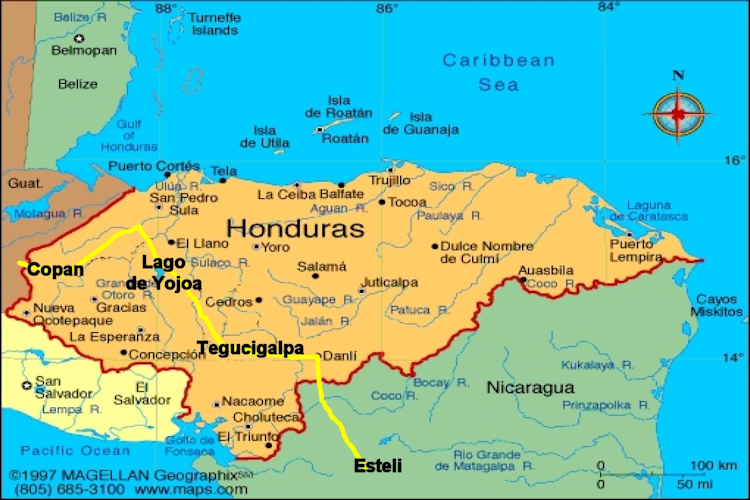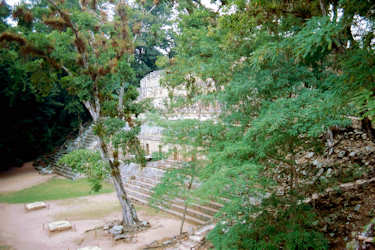Honduras

Historie
In pre-Columbian times, modern Honduras was part of the Mesoamerican cultural area. In the west, the Maya
civilization flourished for hundreds of years. The dominant state within Honduras's borders was that based in Copán.
Copán fell with the other Lowland centres during the conflagrations of the Terminal Classic during the 9th century. The Maya
of this civilization survive in western Honduras as the Ch'orti'
On his fourth and the final voyage to the New World in 1502, Christopher Columbus landed near the modern town of Trujillo,
in the vicinity of the Guaimoreto Lagoon and became the first European to visit the Bay Islands on the coast of Honduras.
On 30 July 1502 Columbus sent his brother Bartholomew Columbus to explore the islands and Bartholomew encountered a Mayan
trading vessel from Yucatán, carrying well-dressed Maya and a rich cargo. Bartholomew's men stole whatever cargo they wanted and
kidnapped the ship's elderly captain to serve as an interpreter in what was the first recorded encounter between the Spanish and
the Maya.
In March 1524 Gil González Dávila became the 1st Spaniard to enter Honduras as a conquistador. Followed by Hernán
Cortés, bringing forces down from Mexico.
Much of the conquest was done in the following two decades, first by groups loyal to Cristóbal de Olid, and then by those
loyal of Francisco Montejo but most particularly by those following Pedro de Alvarado. In addition to Spanish resources,
the conquerors relied heavily on armed forces from Mexico — Tlaxcalans and Mexica armies of thousands who lived on in
the region as garrisons. The Spanish ruled the region for approximately three centuries.
Although the Spanish conquered the southern or Pacific portion of Honduras fairly quickly they were less successful in the northern
or Atlantic side. They managed to found a few towns along the coast, at Puerto Caballos and Trujillo in particular, but
failed to conquer the eastern portion of the region. The Miskito Kingdom, located in the northeast was particularly effective
in resisting conquest. The Miskitos in turn found support from northern European privateers, pirates and especially the British colony
of Jamaica, which placed much of it under their protection after 1740.
Honduras became independent from Spain in 1821 and was for a time part of the First Mexican Empire until 1823 when it became part
of the United Provinces of Central America federation. After 1838 it was an independent republic and held regular elections.
In the late nineteenth century United States-based infrastructure and fruit growing companies were granted substantial land and
exemptions to develop the northern regions. As a result, thousands of workers came to the north coast to work in the Banana
Plantations and the other industries that grew up around the export industry.
During the early 1980s, the United States established a continuing military presence in Honduras with the purpose of supporting
U.S. Government support to El Salvador, the Contra Guerrillas fighting the Nicaraguan government.
Though spared the bloody civil wars wracking its neighbors, the Honduran army quietly waged a campaign against Marxist-Leninist
militias, notorious for kidnappings and bombings. The operation included a CIA-backed campaign of extrajudicial killings by
government-backed units, most notably Battalion 316.
Honduras’ tourist industry was just recovering from Hurricane Mitch, when the September 11, 2001 terror attacks slashed the
number of travelers once more, especially the all-important American diver market. Later that year Hondurans elected Ricardo Maduro
as their president, on promises to promote tourism and, more importantly, to reduce crime.
I have visited Honduras in december 2004
It was part of my 30 days trip to Central America.
These are the places i have seen
Copán
Lago de Yojoa
Tegucigalpa
Please let me know when you're having questions.
i would be pleased to help you.
Things to do and other tips
